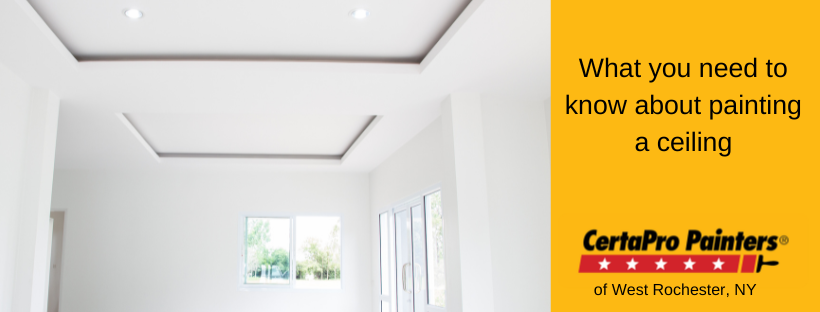
What you need to know about painting a ceiling
Posted on August 30, 2022
Of all the surfaces in your home that you could paint you would think the ceiling in any room would be the simplest and easiest of them all. You just get some flat white paint and roll it on, and that’s it, right?
Well, actually the ceiling is its own special surface in interior painting and has a number of requirements and a number of options you might not know about.
Starting with the paint…
Ceiling paint is not formulated in the same way as wall paint even if they are both water-based latex paints. Ceiling paint has to adhere upside down without dripping off until it dries so the first thing to note is that ceiling paint is made to be thicker than wall paint. It also is often tasked with covering up stains like water stains that you might never get on a wall. The added thickness also hides minor imperfections in your drywall so just applying a thicker formulation of paint can yield multiple benefits.
Ceiling paint is often ignored during repainting. Sometimes the paint on your ceiling has to outlast the wall paint because quick budget redecorating efforts often entail repainting the walls but skipping the ceiling if it looks okay. By okay we mean “it still looks clean and white”.
This can be a mistake though because while your ceiling may look like a uniform color, it might not be the same shade you applied a long time ago. As a white surface, over time it may begin to subtly become grayish. This is because odor and fumes from things like cooking, using a fireplace, burning candles, and using air fresheners can slowly start to darken the color of the ceiling as these fumes gravitate upwards. Cigarette and Cigar smoke will also dramatically impact the color in record time as well.
It’s not unusual for someone to start painting a ceiling with a new can of flat white latex ceiling paint and be shocked at the difference in shades. You often don’t notice how dingy and dirty a ceiling can be till you start to repaint it.
What about the paint finish?
Most ceiling paints dry to a flat finish. For white ceilings having a flat finish removes any glare that might be generated by your room’s lighting and removes the chance of having unintended reflections from the ceiling. For Bathrooms and kitchens, you can try using satin or eggshell finishes where you might want a bit of added light. These finishes tend to be more washable as well.
Why are most ceilings painted white?
White ceilings are probably still carrying over from the days when you lit your home by a candle, lamp, or fireplace. Somehow white just became the default color because it does brighten a room and it does keep the focus on the walls and their color. White also works with just about any décor and wall color choice while making a room feel larger and the walls seem higher.
But you do have color options…
You can take some of your wall color paint and mix it with the ceiling white to create a lighter complimentary shade that ties things together without a stark transition from wall color to the white ceiling. Depending on the room and its purpose you can even completely abandon white for a straight complimentary color. Why not a pale-yellow ceiling in a blue room? Some rooms are more conducive to a non-white ceiling like a dining room, a bedroom, a basement den, or a home office. Where it might be less of an option is in hallways, entryways, laundry rooms, closets, and anywhere you need more light rather than a stylish appearance.
Mixing wall, ceiling, and trim colors may not be for everyone, and not for the faint of heart, but it can produce some dramatic results. Keep in mind however that you may want to sell your home someday and a paint scheme that is well away from what’s expected might work against you.
Thinking about getting your interior freshened up with a bit of painting, ceilings included? Let CertaPro of Rochester West give you a free online estimate or call us at 585-200-5007 and let us make your next paint project a success.





